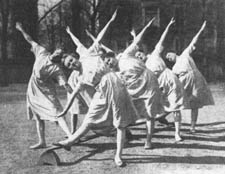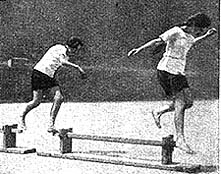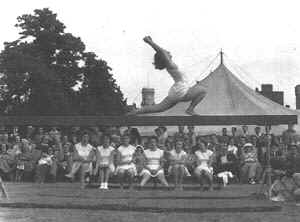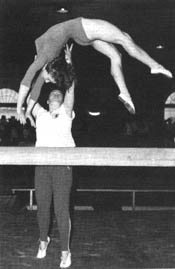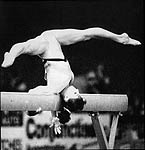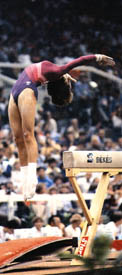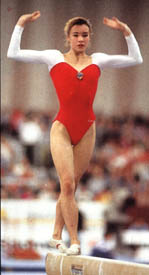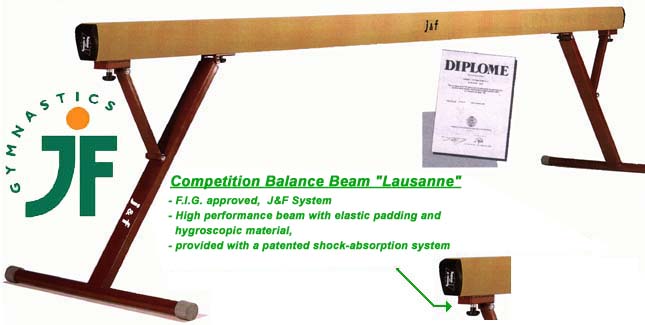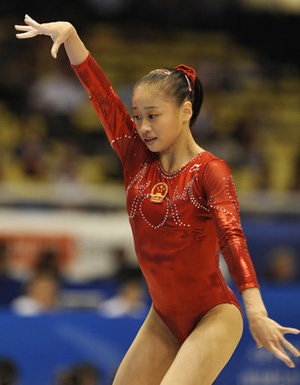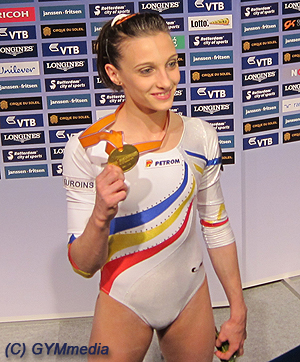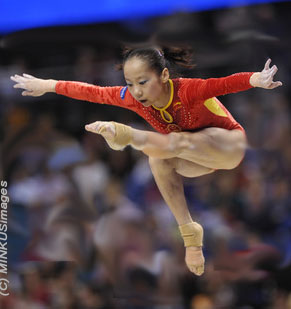 |
History
of Gymnastics on Balance Beam This apparatus is rather lately used in competitive gymnastics. However, as apparatus for balancing it is actually as old as later body exercises. It might started with a "horizontal laying, totally round pine tree trunk..." to balance on. Jahn called it later "Schweben" (engl.: floating) which is the origin of the present name still used in Germany. The lower part of the long "Schwedenbank" (Swedish bench) still integrates the balance beam. |
|
| 1934 the balance beam
was part of the world championships in Budapest for the first time. That
was also the first time actual women's international championships took
place. The beam was only 8 cm wide. Nowadays, this discipline is not only a demonstration of feeling for balance but also of acrobatic of highest difficulty in the artistic area. |
||
This apparatus is rather lately used in competitive gymnastics. As apparatus for balancing, however, it is actually as old as later body exercises. Already Johan Christoph GutsMuths (1759 - 1839) dedicated one chapter to balancing in his pioneering work "Gymnastics for the Youth". His beam was a "horizontal laying, totally round pine tree trunk... of about a length of 64 feet (ca. 20 meters!). The posts wearing the trunk were of that kind that the height can be changed." Friedrich Ludwig Jahn (1778 - 1852) takes GutsMuths' balancing on the round beam over in his "Deutsche Turnkunst" (German Art of Gymnastics, 1816), but being a declared enemy against foreign words he calls it "Schweben" (floating):
"Schweben means being in balance: in rest as well as in action". Jahns "Schwebebaum" is "a slim, straight-grown and smooth resinous pinewood or fir tree trunk; the longer, the better, and not good under a length of 40 feet and a diameter of 10 inches at the end of the trunk. It rests between to pairs of strong posts on bolts of iron which can be put high or low". Jahn did not attach great importance to perfect stability of the apparatus, on the contrary: "It must not sway too much, not too little, but it must have the proper life" (The German Art of Gymnastics, 1816). |
|
|
Later on this (low) balance beam was taken over into school's physical
education by German followers of Ling's system, (Hugo
Rothstein; first director of the Prussian Central Institution
of Gymnastics in Berlin), even though Rothstein lost influence because
of the "quarrel about bars" in 1863. Gymnastics pioneers Spieß (1810 - 1858) and Kloß (1818 - 1881) thought highly of this low balance beam as apparatus for
girls' gymnastics. As competition apparatus this low and narrow balance beam was never used. From now onwards balance beam became a standard apparatus in women's international competitive gymnastics. The routines tended to include an increasing number of acrobatic elements. As a consequence the wish for firmer foothold grew permanently stronger to enable gymnasts to perform more difficult leaps and rolls.
The stability of the
5 m long beam had to be ensured
as well as a certain elasticity that is described in this regulation:
"At a height of 1200 mm and with a testing load of 135 kg in the
middle of the beam it is ought to bend a maximum of 8 mm" (Book
of Norms, edition 1965, page 31). Such precise regulations highly guaranteed
uniformity for international competitions; everywhere in the world the
balance beam secured equal opportunities which is one of the basic laws
of any fair competition in Olympic artistic gymnastics. The acrobatic
coined gymnastics on beam challenged designing engineers as well as
people responsible of the International Federation of Gymnastics.
When somersaults and
free handsprings on beam became
increasingly standard, improvements of the beam had to follow as it
is stated in this demand, for instance: "The beam must have an
elastic overlay... In spite of a certain elasticity it has to ensure
a safe footstand and good balance. The sheath must be tearproof as well
as grippy and firmly fixed to the beam" (Book of Norms by FIG).
In 1974 only "safety of footstand" was mentioned, but in 1979 this safety is defined more precisely: Then it says: "...To prevent injuries after falls the surface must be designed to give in at least 5 mm at the maximum loading capacity at the point of load incl. edges". The risk of injury is explicitly mentioned: "The ends must be padded to prevent injuries. (Translation/Webdesign:
|
|||||||||||||||||||
| . |
Janssen&Fritsen presents ... |
|
* TOKYO 2011 |
|
World Champion Balance Beam
World Champion 2010
World Champion 2009 *** |
GYM Partner 
|
 ... here is the place for YOUR >BANNER< ! 
... effizient werben >HIER!< |

